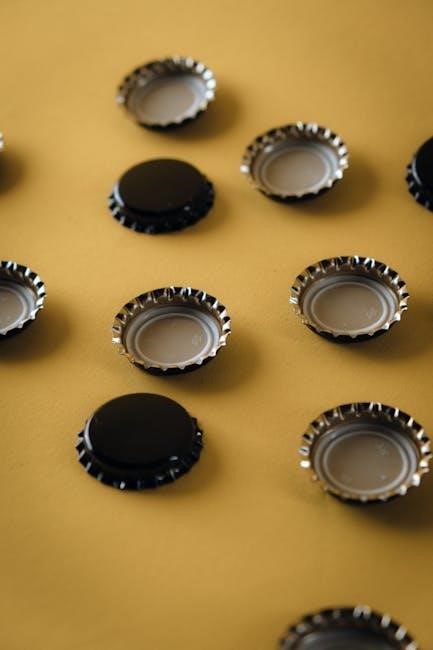The 10-20 EEG electrode placement system is the standard method for positioning electrodes on the scalp, ensuring consistent and reliable data collection in both clinical and research settings.
Brief Overview of the 10-20 System
The 10-20 EEG electrode placement system is an internationally recognized standard for positioning electrodes on the scalp. Named for its 10% and 20% intervals along the scalp’s circumference, it ensures consistent and reproducible electrode placement. This system was developed to standardize EEG procedures, making it easier to compare data across studies and institutions. The electrodes are arranged symmetrically, with labels based on brain regions (e;g., frontal, central, parietal, occipital). This method balances comprehensive scalp coverage with practical simplicity, making it suitable for both clinical diagnostics and research. Its widespread adoption has made it a cornerstone of EEG research and clinical applications worldwide.
Importance of the 10-20 EEG Electrode Placement System
The 10-20 system ensures standardization, enabling consistent and reliable EEG data collection. Its widespread adoption guarantees validity and reproducibility in research and clinical diagnostics, advancing neuroscience and neurology.
Standardization in Clinical and Research Settings

The 10-20 EEG electrode placement system ensures consistency and accuracy in both clinical and research environments. By standardizing electrode positions, it facilitates reliable data collection and interpretation across studies. This system is widely adopted for its ability to minimize variability, enabling researchers to compare results seamlessly. In clinical settings, it aids in diagnosing neurological disorders, while in research, it supports studies like event-related potentials (ERPs). The international recognition of the 10-20 system ensures that findings are reproducible and comparable, making it indispensable for advancing neuroscience and neurology. Its standardized labeling and placement guidelines simplify collaboration among institutions, reinforcing its role as a cornerstone in EEG practices.
Role in Event-Related Potentials (ERPs) Studies
The 10-20 EEG electrode placement system plays a pivotal role in event-related potentials (ERPs) studies by providing a standardized framework for capturing neural responses to specific stimuli. ERPs are time-locked electrical signals in the brain, and the 10-20 system ensures consistent electrode positioning, which is critical for reliable data collection and analysis. The symmetrical and systematic arrangement of electrodes allows researchers to accurately localize and interpret ERP components, such as the P300 or N400. This standardization facilitates cross-study comparisons and enhances the reproducibility of findings. The 10-20 system is particularly advantageous in ERP research due to its ability to balance spatial resolution with practicality, making it a cornerstone in both clinical and cognitive neuroscience applications.

Key Principles of the 10-20 Electrode Placement
The system is based on international standardization, ensuring symmetrical and equal intervals between electrodes, providing comprehensive scalp coverage for accurate cerebral cortex area measurements.
International Standardization and Labeling
The 10-20 EEG electrode placement system is an internationally recognized standard, recommended by the International Federation of Clinical Neurophysiology. It ensures uniformity in electrode placement across studies, reducing variability and enhancing reproducibility. The system labels electrodes based on brain regions: F (frontal), C (central), P (parietal), O (occipital), and A (auricular). Intermediate positions, such as Fp1 or C4, provide higher resolution. This standardized labeling allows researchers to compare data seamlessly, fostering collaboration and consistency worldwide. The system’s symmetrical arrangement ensures balanced scalp coverage, with electrodes spaced at equal intervals. This methodological harmony is crucial for both clinical diagnostics and research, making the 10-20 system a cornerstone of EEG practices globally.
Scalp Coverage and Symmetrical Arrangement
The 10-20 EEG electrode placement system emphasizes even scalp coverage and a symmetrical arrangement of electrodes to ensure accurate and reproducible recordings. This method divides the scalp into equal sections, with electrodes placed at specific intervals to maximize data collection from all cortical areas. The system’s symmetry ensures balanced coverage across both hemispheres, allowing for precise comparisons between different brain regions. Proper alignment with anatomical landmarks, such as the nasion and inion, guarantees consistency. This standardized approach minimizes variability and enhances the reliability of EEG results in both clinical and research applications. The symmetrical design also facilitates the interpretation of brain activity patterns, making it a cornerstone of modern EEG practices.

Electrode Positions in the 10-20 System
The 10-20 system defines specific electrode positions on the scalp, including standard locations like Fp, F, C, P, O, and A, ensuring symmetrical and precise placement for accurate EEG recordings.
Standard Electrode Locations (Fp, F, C, P, O, A)

The 10-20 EEG electrode placement system defines specific locations for electrodes, ensuring standardized data collection. The primary electrode positions include Fp (prefrontal), F (frontal), C (central), P (parietal), O (occipital), and A (auricular reference). These locations are strategically chosen to cover key regions of the cerebral cortex. Fp electrodes are placed on the forehead, capturing prefrontal activity, while F electrodes target frontal lobe functions. C electrodes are positioned over the central cortex, often associated with motor and sensory functions. P electrodes cover the parietal lobe, linked to sensory processing, and O electrodes are placed at the back of the head to measure occipital activity, particularly visual-related potentials. A electrodes are used as reference points, typically placed on the ears. This standardized arrangement ensures consistent and comparable EEG recordings across studies.
Intermediate Electrode Positions (Fp1/2, F3/4, C3/4, P3/4, O1/2)
The intermediate electrode positions in the 10-20 system, such as Fp1/2, F3/4, C3/4, P3/4, and O1/2, are placed between the standard electrodes to provide higher spatial resolution. These positions are labeled with numbers to indicate their location midway between the standard electrodes. For example, Fp1 and Fp2 are positioned laterally from the frontal poles, while F3 and F4 are intermediate between Fz and the mastoids. Similarly, C3/4 and P3/4 are placed between the central and parietal electrodes, and O1/2 are intermediate between the occipital and parietal regions. These positions enhance the ability to detect lateralized or localized brain activity, making them crucial for detailed EEG analysis in both clinical and research applications.
Additional Electrode Positions in Extended Systems
Beyond the standard 10-20 EEG electrode placement, extended systems incorporate additional electrodes to provide higher spatial resolution. These systems, such as the 64-, 128-, or 256-channel setups, include electrodes placed at intermediate or additional scalp locations. For instance, electrodes like Fp3, Fz, Cz, and Pz may be added to refine data collection from specific cortical regions. These extended systems are particularly useful in research to capture nuanced brain activity patterns, especially in studies focusing on event-related potentials (ERPs) or cognitive neuroscience. However, the increased complexity requires precise placement to maintain accuracy. The 10-20 system remains the foundation, with extended systems building upon it to meet specialized needs.

Application Guide for 10-20 EEG Electrode Placement
The 10-20 system provides a standardized approach for electrode placement, ensuring consistency and accuracy in both clinical and research settings with clear preparation and placement guidelines.

Preparation and Measurement Techniques
Proper preparation is essential for accurate EEG recordings. The scalp should be cleaned to remove oils and dirt, and hair should be brushed to ensure good electrode contact. Conductive gel or paste is applied to reduce impedance between the electrode and scalp. Measurement techniques involve determining electrode positions using anatomical landmarks, such as the nasion, inion, and preauricular points. The 10-20 system relies on dividing the scalp into equal intervals, typically 10% or 20% of the distance between these landmarks. Accurate measurements ensure correct placement, which is critical for reliable data collection. Tools like measuring tapes and diagrams are often used to guide placement. Proper preparation and measurement techniques are vital for achieving high-quality EEG signals and ensuring the validity of results in both clinical and research settings.
Step-by-Step Placement Process
The 10-20 EEG electrode placement process begins with proper scalp preparation, ensuring cleanliness and removing hair or skin oils. Measure the head to locate key landmarks like the nasion and inion. Divide the scalp into equal segments using the 10% and 20% distances between these points. Apply electrodes symmetrically, starting with reference points (e.g., Cz) and proceeding to other locations. Use conductive gel to secure electrodes and ensure low impedance. Label each electrode according to its position (e.g., Fp1, F2). Verify electrode placement accuracy and impedance levels for optimal signal quality. This systematic approach ensures consistency and reliability in EEG recordings.
Advanced Topics in 10-20 EEG Electrode Placement
High-density EEG systems offer higher spatial resolution compared to the standard 10-20 system, while troubleshooting common placement errors ensures accurate data acquisition and reliable results in research and clinical applications.
High-Density EEG and Its Comparison to the 10-20 System
High-density EEG systems utilize a much larger number of electrodes (e.g., 64, 128, or 256) compared to the 10-20 system, offering higher spatial resolution for brain activity mapping.
While the 10-20 system provides a balanced approach for clinical and research applications, high-density systems are preferred for detailed cortical mapping and localization of neural activity.
However, high-density setups are more complex, requiring specialized equipment and expertise, making the 10-20 system advantageous for its simplicity and cost-effectiveness in routine applications.
The choice between systems depends on the study’s goals, with high-density EEG offering superior precision for advanced research and the 10-20 system ensuring standardization and accessibility.
Troubleshooting Common Placement Errors
Common errors in 10-20 EEG electrode placement include mislabeling electrodes, incorrect measurement techniques, and inadequate scalp preparation. Improper placement can lead to poor signal quality or data misinterpretation. Ensuring symmetry and accurate landmarks is crucial. Issues like asymmetrical placement or incorrect reference points can distort results. Additionally, failing to check electrode impedances or improper securing of electrodes can cause artifacts. Regular verification of electrode labels and positions is essential to maintain accuracy. Proper training and adherence to the 10-20 system guidelines help minimize errors, ensuring reliable and reproducible EEG recordings.
- Mislabeling electrodes
- Improper measurement techniques
- Inadequate scalp preparation
- Asymmetrical placement
- Incorrect reference points
- High electrode impedances
The 10-20 EEG electrode placement system remains a foundational tool in neuroscience, offering a standardized approach for consistent data collection and analysis in clinical and research settings.
Future of EEG Electrode Placement Systems
The future of EEG electrode placement systems is poised for significant advancements, driven by technological innovations and growing demand for precise neurophysiological monitoring. High-density EEG arrays and dry electrode technologies are expected to replace traditional systems, offering higher spatial resolution and convenience. Wireless EEG devices will likely become more prevalent, enabling seamless data acquisition in diverse settings. Integration with artificial intelligence and machine learning will enhance data analysis, improving diagnostic accuracy and personalized treatment plans. Additionally, advancements in non-invasive brain-computer interfaces (BCIs) will rely on refined electrode systems for better signal capture. These developments promise to expand EEG applications in clinical diagnostics, cognitive research, and neurofeedback therapy, ensuring the 10-20 system evolves to meet future demands while maintaining its foundational role in neurophysiology.

